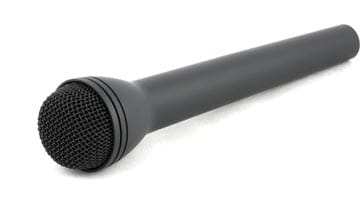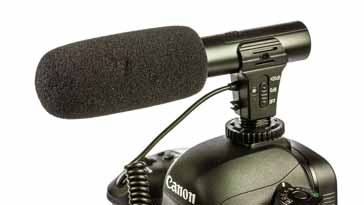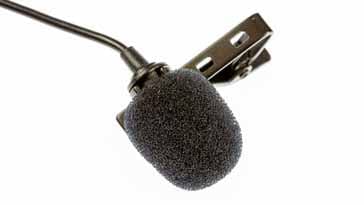Video & Vlogging Microphones: DSLR; Camcorder; Smartphone
One of the main requirements to produce high quality video is good audio and this requires a good microphone - wired, shotgun, handheld, wireless, USB and even Bluetooth can all be used as appropriate.
Microphone Tutorial Includes:
Microphone basics
Microphone types
Microphone specs
Microphone directionality
Dynamic microphone
Condenser microphone
Electret microphone
Ribbon microphone
Crystal / ceramic microphone
Boundary / PZM microphone
Carbon microphone
How to buy best microphone
Microphones for video
Microphones for vocals/ singing
YouTube and other platforms provide an excellent option for people wanting to make and share video content. Some even make a good living at it but running advertisements and providing reviews and the like.
Many people run video blogs or vlogs using a variety of equipment. Obviously the content must be good, but in terms of the actual quality of the video, two elements are key: audio and lighting.
In terms of the audio quality it is often the microphone that is the main determining element. Whilst there is often a small on-board microphone in many cameras, this seldom provides good quality audio, picking up echo and many other extraneous sounds. There are many good microphone options for capturing good quality audio.
Camera options for video and vlogging
Whilst the microphone is the key element for capturing good quality audio content, the type of microphone may depend upon the camera used, so before looking at microphones a quick review of some of the main camera options is useful.
Today many cameras offer near broadcast quality video, so it can very much be a matter of personal preference about what may be used.
- DSLR: Digital singe lens reflex cameras offer a really great option for creating video. Virtually all DSLRs provide a video function that provides excellent quality. They normally have small on-board microphones and normally a 3.5mm jack for the microphone input. With either the built-in microphone or an external microphone, the sampling rate is 44.1 KHz and the bit count is 16 bits for both Land R channels.
- Compact camera: Virtually all compact cameras and bridge cameras offer good quality video and they may have the option for using an external microphone, but check before buying. These cameras are smaller, and often more convenient to carry than DSLRs, and they may cost less.
- Camcorders: Camcorders are possibly used less than DSLRs and other options as generally the video quality from all options is exceedingly good these days. However camcorders may provide a good option for many. Again, they have an on-board microphone which will be omnidirectional and suffer the same issues as other on-board microphones.
- Smartphones: A huge amount of development has been invested into the cameras in smartphones and as a result they offer very high quality video capture, although possibly not with all the frills and adjustments that may be available on other cameras. Like the other options, the on-board microphone is seldom particularly good for serious video capture. It is normally possible to have an external microphone through the earphone jack, or in the case of the iPhone, through the lightning connector.
- Professional video camera: Professional video cameras are very expensive and offer exceptional quality . . at a price. They would be expected to use an external microphone
Microphone options for video capture
There are several different options of microphone that can be used for capturing video. The type of microphone selected will depend upon the situation and the camera used.
Wired microphone: This is the most obvious choice, and possibly the most reliable. There are several different forms of wired microphone that can be used for video:
Handheld microphone: These microphones can work well, but they tend not to be used as much. Often for video interviews an omnidirectional microphone may be used, but sometimes a cardiod microphone may offer good results. These microphones can offer good results as they can be brought close to the speaker to cut out surrounding noise. Handheld microphones tend to have XLR connectors and these normally use quite thick wire. As this can be heavy, some weight relief may be needed to prevent too much strain on the camera connector which can be a small type. It also me be necessary to convert from an XLR or quarter inch jack connector to a smaller 3.5 mm jack or other connector that is needed.

Handheld dynamic microphone Shotgun microphone: Shotgun microphones are directional microphones that are often designed for use on a camera. Being quite directional they offer considerable degrees of extraneous noise reduction.
Good quality shotgun microphones can also cut down echo in a room and provide a good solution for many other video and vlogging applications where they can cut down extraneous noise whilst still offering considerable degrees of convenience.
The shotgun microphone has the characteristic long shape, its maximum response being along the axis of the microphone. The actual directional response will depend upon the actual microphone, but check with the specification before buying. That said, many will be very good for many applications.

A shotgun microphone on a camera Lavalier microphone : A lavalier microphone or lapel microphone is a small microphone that can be clipped onto the speaker’s clothes about “heart” height. Being close to the speaker, it can give good performance for interviews and other applications where people are speaking at the camera.
Lavalier microphones are omnidirectional and therefore don’t give the optimum noise reduction, but as they are very close to the speaker, this is not normally an issue. To cut down the impact of plosive sounds like "p", "b", . . etc. they may often be angled downwards away from the speaker’s mouth, in this way they rely on the omnidirectional capability to provide adequate response.

Lapel or lavalier microphone
Wireless microphones: There is a good selection of wireless microphones. These normally consist of a microphone with wireless interface and a separate receiver which can be located with the camera.
When using a wireless microphone, check that the receiver can be conveniently located with the camera. Some have a hot shoe adapter specifically for use with DSLR or other cameras that may have a hot shoe flash attachment.
Bluetooth microphone: There are very few Bluetooth microphones available. The karaoke microphones that can be seen on many websites are not suitable for video as they only receive music from a Bluetooth transmitter / source and then mix the received audio with the microphone sound and output this to headphones or an amplified with a wired connection.
A true Bluetooth microphone enables a Bluetooth connection to be established from the microphone to the smartphone removing all wired connections. By using a Bluetooth microphone for vlogging, the connection to the smartphone is made much easier and it is not necessary to use the leads that constrain many other forms of microphone. Whilst wired connections are normally more reliable, the wireless one is more convenient. Using Bluetooth means that it can connect directly to the smartphone using its inbuilt Bluetooth capability - other wires microphones need a separate receiver which needs to be wired to the camera.
The camera App native in smartphones may not be able to accept audio via a Bluetooth connection. As a result it will be necessary to download a camera app that can accommodate this. One may be available with the Bluetooth microphone.
USB microphones: Another option that is widely used by many video makes and vloggers is a USB microphone.
The USB microphone can link in to a computer and provide digitised audio rather than needing to use the digital conversion in the computer. These microphones tend to be desktop types that can be used whilst recording from home or at the base location. Some USB microphones can provide excellent quality, but as always the price generally reflects the overall performance.>
Microphone connections
One of the points to bear in mind when buying a microphone for use whilst recording video is the connections.
Care needs to be taken when using the small 3.5mm jack connectors as the connections are different for smartphones and DSLR and other cameras.
- DSLR - TRS connector : The DSLR camera typically has a three connection or what used to be called a stereo 3.5mm jack with a Tip, Ring and Sleeve connection (hence the name TRS). The tip carries the left channel and the ring has the right channel. Earth, ground, common is the sleeve.
- Smartphone TRRS connector : Smartphones require an additional ring so that they can carry both the headphones (left and right) along with the microphone so people can used headsets for making phone calls. These connectors with the additional ring are called TRRS, i.e. tip, ring, ring, sleeve. The convention for these is that the tip carries the headphones left channel, right channel is carried by the adjacent ring. The next ring carries the microphone and the sleeve is the common ground. Apple iPhones have the microphone carried by the sleeve and the adjacent ring is the common.
There are many microphone options that can be used for video making and vlogging. The choice depends upon the situation and usage as well as personal preferences.
 Written by Ian Poole .
Written by Ian Poole .
Experienced electronics engineer and author.
More Audio Video Topics:
HDMI
SCART
DisplayPort
DVI
Loudspeaker technology
Headphones & earphones
Bluetooth speakers
Stereo sound
Microphones
Audio compact cassettes
Vinyl record technology
Digital radio
DVB television
Return to Audio / Video menu . . .



